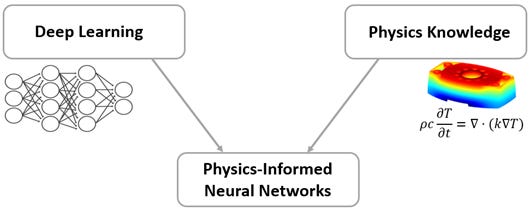AI & Agents in Engineering, Optical Engineering & Learning Physics from Experiments
📚 "The ideal engineer is a composite, using knowledge and techniques from various disciplines to solve engineering problems.” – N.W. Dougherty
💻 Physics-Informed Neural Networks (PINNs)
Physics-informed neural networks (PINNs) are neural networks that incorporate physical laws described by differential equations into their loss functions to guide the learning process toward solutions that are more consistent with the underlying physics. PINNs can be used to:
Approximate solutions to partial differential equations (PDEs) and ordinary differential equations (ODEs).
Solve inverse problems, such as estimating model parameters from limited data.
With Deep Learning Toolbox™, you can build and train PINNs, which enable rapid predictive analysis. You can integrate PINNs with MATLAB® and Simulink® for system-level simulation, control design, and design optimization.
🚀 What is Autodesk NAVPACK?
Autodesk NAVPACK revolutionizes the product development process through AI based tools that enable cross-disciplinary collaboration, apply organization expertise, and empower designers with more information earlier to increase product quality and shorten time to market.
Accelerate design optimization: Reduce manual iterations and speed up product development.
Enhance product performance: Optimize designs for structural, thermal, and fluid dynamics efficiency.
Streamline engineering workflows: Simplify processes, reduce manual steps, and improve product performance.
💻 Optical Engineering Breakthroughs - A Deep Dive with Jim Shaw
In this insightful QnA session, James Shaw examines contemporary optical engineering methodologies. The discussion covers optical miniaturization challenges, Zemax multi-physics simulation for structural-thermal-optical analysis, and Lumerical's GPU-accelerated photonics for LiDAR/sensor development.
🧠 Learning governing physics from output only measurements
Extracting governing physics from data is a key challenge in many areas of science and technology. The existing techniques for equations discovery are dependent on both input and state measurements; however, in practice, we only have access to the output measurements only. We here propose a novel framework for learning governing physics of dynamical system from output only measurements; this essentially transfers the physics discovery problem from the deterministic to the stochastic domain.
The results obtained indicate the potential of the proposed approach in identifying governing physics from output only measurement.
🎬 Video of the Week
💻 Engineering Tool of the Week – Code-Aster
Code-Aster is a free FEA program that offers structural analysis and thermodynamic analysis. Their documentation shows a very large list of nonlinear analysis capabilities, including internal coupling analysis, mechanical, thermal loadings, dynamics (modal analysis, linear transient response, etc.), thermal analysis, and much more.
📚Book of the Week
Turbulence: The Legacy of A. N. Kolmogorov
This textbook presents a modern account of turbulence, one of the greatest challenges in physics. The state-of-the-art is put into historical perspective five centuries after the first studies of Leonardo and half a century after the first attempt by A. N. Kolmogorov to predict the properties of flow at very high Reynolds numbers. Such 'fully developed turbulence' is ubiquitous in both cosmical and natural environments, in engineering applications and in everyday life.
The intended readership for the book ranges from first-year graduate students in mathematics, physics, astrophysics, geosciences and engineering, to professional scientists and engineers. Elementary presentations of dynamical systems ideas, of probabilistic methods (including the theory of large deviations) and of fractal geometry make this a self-contained textbook.
Let’s connect on Instagram or LinkedIn!
For any business-related issues or collaborations, email me at support@jousefmurad.com!
Keep engineering your mind! 🧠
Jousef








